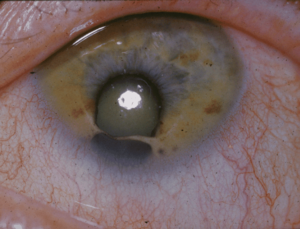Cat-eye syndrome
| Cat eye syndrome | |
|---|---|
 |
|
| An example of the defect after which CES is named. | |
| Classification and external resources | |
| Specialty | medical genetics |
| OMIM | 115470 |
| DiseasesDB | 29864 |
| Orphanet | 195 |
Cat eye syndrome (CES), or Schmid–Fraccaro syndrome, is a rare condition caused by the short arm (p) and a small section of the long arm (q) of human chromosome 22 being present three (trisomic) or four times (tetrasomic) (usually 3 times) instead of the usual two times. The term "cat eye" syndrome was coined because of the particular appearance of the vertical colobomas in the eyes of some patients. However, over half of the CES patients in the literature do not present with this trait. There is no significant reduction in life expectancy in patients who are not afflicted with one of CES' life-threatening abnormalities.
The additional chromosome 22 usually arises spontaneously. It may be hereditary and parents may be mosaic for the marker chromosome but show no phenotypic symptoms of the syndrome.
The chromosomal area included in the cat eye syndrome "critical region" is 22pter→q11.
The abnormalities common to cat eye syndrome were first cataloged in 1899. It was described in association with a small marker chromosome in 1965. Early reports of cat eye syndrome discuss the possibility of chromosome 13 involvement. Now, CES is considered to be present with the chromosome 22 trisomy findings.
...
Wikipedia
